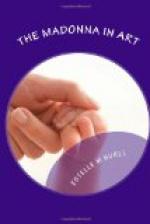Unattractive as such pictures are to us from an artistic standpoint, they inspire us with respect if not with reverence. Once objects of mingled devotion and admiration, they are still regarded with awe by many who can no longer admire. Their real origin being lost in obscurity, innumerable legends have arisen, attributing them to miraculous agencies, and also endowing them with power to work miracles. There is an early and widespread tradition, imported with the Madonna from the East, which makes St. Luke a painter. It is said that he painted many portraits of the Virgin, and, naturally, all the churches possessing old Byzantine pictures claim that they are genuine works from the hand of the evangelist. There is one in the Ara Coeli at Rome, and another in S. Maria in Cosmedino, of which marvellous tales are told, besides others of great sanctity in St. Mark’s, Venice, and in Padua.
It would not be interesting to dwell, in any detail, upon these curious old pictures. We would do better to take our first example from the art which, though founded on Byzantine types, had begun to learn of nature. Such a picture we find in the Venice Academy, by Jacopo Bellini, painted at the beginning of the fifteenth century, somewhat later than any corresponding picture could have been found elsewhere in Italy, as Venice was chronologically behind the other art schools. The background is a glory of cherub heads touched with gold hatching. Both mother and child wear heavy nimbi, ornamented with gold. These points recall Byzantine work; but the gentler face of the Virgin, and the graceful fall of her drapery, show that we are in a different world of art. The child is dressed in a little tunic, in the primitive method.
With the dawn of the Italian Renaissance, the old style of portrait Madonna passed out of vogue. More elaborate backgrounds were introduced from the growing resources of technique. In the fifteenth and sixteenth centuries, pictures of the portrait style were comparatively rare. Raphael, however, was not above adopting this method, as every lover of the Granduca Madonna will remember. His friend Bartolommeo also selected this style of composition for some of the loveliest of his works.
[Illustration: JACOPO BELLINI.—MADONNA AND CHILD.]




